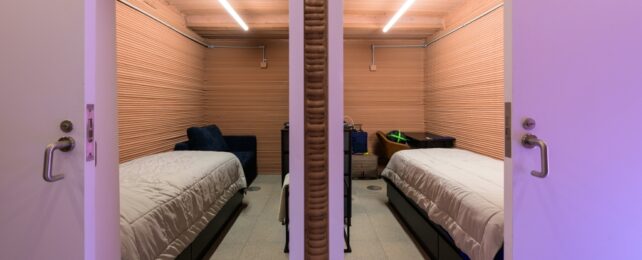On June 25, 2023, a crew of four volunteers entered a simulated Martian habitat, from which they will not emerge for over a year. Their mission: to learn more about the logistics – and the human psychology – of living long-term on another planet, without ever leaving the ground.
The mission is called CHAPEA (Crew Health and Performance Exploration Analog) and is the first of three planned simulations between now and 2026, each of which will teach scientists progressively more about what it takes for long-duration human spaceflight to succeed.
CHAPEA is based at NASA's Johnson Space Centre in Houston, Texas. The habitat, called Mars Dune Alpha, is a 1700 square-foot 3D-printed living space, in which the crew will live, work, exercise, sleep, and perform experiments.
Through the magic of virtual reality, the mission will also involve Extra Vehicular Activities (EVAs), in which crew members will briefly leave their habitat to enter an adjacent enclosure complete with red sand. They will have to don space suits for these simulated spacewalks.
The four-member crew has a stellar collective CV, including Kelly Haston (a biologist), Ross Brockwell (a structural engineer), Nathan Jones (a physician), and Anca Selariu (a Navy microbiologist). They had to pass the same testing as astronaut candidates do before being approved for a mission.
"The knowledge we gain here will help enable us to send humans to Mars and bring them home safely," said Grace Douglas, the Principal Investigator of CHAPEA, just before the volunteers ingressed into their habitat.
There is more to the mission than just close quarters. The crew will only be able to communicate with the outside world on a time delay. On Mars, messages can take up to 22 minutes to reach Earth, and that restriction is being applied to CHAPEA (that's 44 minutes round-trip).
The crew will also follow a diet of freeze-dried foods, similar to what Martian astronauts will have to eat, and keep a schedule of activities similar to a real mission.
"They are about to embark on an analog mission that encompasses operations, logistics, and research of living and working on Mars. The importance of this study cannot be overstated," says Judith Hayes, Chief Science Officer, Human Health and Performance Directorate.
"NASA scientists will learn critical insights on the physical and behavioral aspects of a mission on Mars."
Even the habitat itself is designed with space missions in mind. Bringing everything you need to Mars from Earth is cost prohibitive, so their habitat was 3D printed to test out in-situ resource utilization technologies.
The habitat includes features like airlocks, hatches, and a medical station. While the crew can leave for medical emergencies, they hope they will be able to deal with minor health concerns independently.
Of course, CHAPEA can't simulate everything. The crew will not have to deal with Martian gravity, for example. But there will be 'surprise' challenges, like equipment failures or water shortages.
Ultimately, the idea of CHAPEA is to learn what human behavioral challenges might arise in an extended mission. By practicing here on Earth, NASA can be more prepared for future Mars-bound astronauts to do it for real.
The CHAPEA1 crew will emerge from their isolation in July 2024.
This article was originally published by Universe Today. Read the original article.
